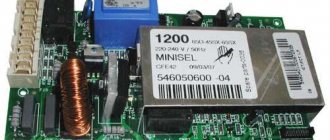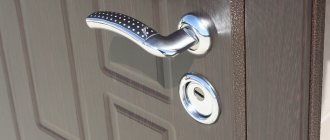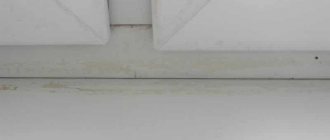Today we will touch on a sore subject for car enthusiasts, since there is dampness in most garages. It is formed in the presence of condensation. This leads to increased humidity in the garage itself. Everyone knows that moisture is very harmful for a car, as well as for the entire building. It can easily ruin the finish and other structures. It is not recommended to leave a car in such a room; moisture can damage it. The interesting thing is that only some areas of the walls or ceiling can become damp; this will help you determine the source, and behind the source, the cause.
In our article you can find many useful tips that will help you get rid of dampness in your garage.
Causes of dampness in the garage
If you notice that there is high humidity in your garage, you probably want to know the reason why it appeared. After all, if you know the reason, it’s easy to deal with humidity.
Let's consider two reasons:
- There is no ventilation in the room. It happens that during the construction of a garage they forgot to take this factor into account. In addition, the hoods may be faulty.
- Incorrect or poorly installed waterproofing. If your floor is not concrete, exposed soil encourages moisture to build up. When your garage has a cellar or inspection hole, then in the absence of ventilation, dampness is inevitable.
Why does dampness appear in the garage basement in winter? There can be many reasons, but this usually happens due to high humidity. When the sun appears, everything begins to melt, and then dampness appears. And condensation forms because it’s cold outside the garage and warm inside.
Why is excess moisture in a room dangerous?
Let's start with the fact that there is nothing good in a waterlogged atmosphere in a garage - neither for humans, nor for machinery or equipment. Mold and mildew will inevitably appear, and metal objects will begin to actively oxidize. When spending a long time in such a garage, people feel discomfort. There are possible options for the development of pulmonary diseases and the penetration of infections into the body.
Electrical circuits are destroyed. When condensation forms in switches and sockets, this is unsafe for humans. And a car sitting in a damp garage behaves unpredictably. And the body inevitably becomes covered with corrosion pits.
Installation of waterproofing for a garage
In many cases, dampness in the garage occurs when there is no concrete floor. If you are building a garage yourself, do not be lazy to fill the floor; damp soil will have a bad effect on the room, and in the end all the work will be done down the drain. After all, the garage will not justify itself, but will bring even more problems.
Therefore, it is necessary to fill the screed with reinforcement. But don’t forget, all this should be done on a bed of gravel and sand.
It must be remembered that the screed does not prevent the appearance of dampness in all cases. Groundwater, which may be close to the base of your garage, interacts well with concrete, and it, in turn, releases the resulting moisture into the room.
Important! Before starting work, find out the groundwater level in the area of your garage. If water is close, be sure to install waterproofing.
It happens that a concrete screed is installed simply without waterproofing. There is a solution to this problem: insulate the surface with a self-leveling floor. A thin layer will be enough to prevent moisture from entering the garage.
In concrete garages that are not insulated, moisture can enter through the walls, namely through their base. In this case, you will need a special grease for walls; it is applied to the inside of the wall. Thanks to it, the wall will not become damp. But, do not apply the mixture very close to the floor, the distance from the base of the wall should be 30–40 centimeters, and you need to isolate the joints that are located between the inner wall and the floor.
Optimal temperature and humidity conditions
To store vegetables, the temperature should be 2 - 4 degrees with a humidity of up to 93%.
To make the cellar dry in the garage, you should understand the parameters of the final result, which corresponds to the standards for maintaining basements in garage blocks.
As a rule, a vegetable cellar is built under the building, where vegetables, fruits and twists are stored. If there is excess humidity, the fruits become damp and disappear, and if the air is too dry, they dry out. Therefore, it is necessary to dry the subfloor taking into account these features.
The optimal indicators are:
- relative humidity - 85-93%;
- temperature - +2-4ºС.
Clay has high thermal conductivity when wet and partially retains it when dry. Sandy loam and sand do not retain water, as a result of which they practically do not conduct heat and cold.
Installation of ventilation in the garage with your own hands
As we discussed earlier, one of the reasons for dampness in the garage is the lack of ventilation. If you look at the requirements for standard garages, it says that ventilation in the garage should circulate air at approximately 180 m3/hour.
You should know that you have three options for installing ventilation. You can do this yourself, without the extra costs of professional builders.
Air circulation naturally
This type of ventilation works due to the difference between the temperature inside the room and the ambient temperature. The difference in atmospheric pressure also takes part in the process.
How to create this type of ventilation in a garage?
To do this you will need:
- Buy the required number of pipes for ventilation (often they are made of plastic).
- Then you need to make holes in the garage itself to install the pipes.
The beginning of the pipe should be as close to the floor as possible, while at the same time the end should be as high as possible, in many cases on the roof. To take full advantage of the capabilities of the ventilation pipes, you must install a special mushroom, many use a swing ejector. This is necessary so that the wind, with the help of an ejector, can pull excess air out of the room. Thus, preventing the appearance of dampness.
Forced air circulation
Before starting work with drying the garage, you must take care of installing electricity, because this method involves the use of fans, and they run on electricity. This method is very similar to the previous one, because you install the pipes in the same way, but there should be fans at the beginning and at the end. The units will circulate air in the garage for several hours a day, regardless of the weather outside.
Important! But what about those who have a garage far from home and do not have the opportunity to visit it every day to turn on the fans? There are solutions to this problem. After all, you can buy a fan with a built-in turn-on timer; you won’t need to go to it every day. But such pleasure differs significantly in price from conventional fans. There are solutions to this too. You can buy a separate electrical timer that is installed on the power cable of the fan itself.
Combined air circulation
Such a system includes the installation of only one fan; it is installed either at the beginning or at the end of the pipes (the end of the pipes is on top). You must determine the location of the fan yourself. After installation, you can begin to dry the room.
Advice! Most recommend installing a fan at the end of the pipes. Because this allows you to avoid installing high pipes above the garage. It is also much easier for the fan itself to work in winter.
Quick drying using a broiler
You can remove excess air humidity and condensation from the cellar using the simplest fryer. This small (portable) device can be found in almost any country farm. In any case, you can ask your neighbors.
The fryer quickly heats the air in the room.
Before drying the cellar using a roasting pan, it is necessary to partially get rid of excess dampness by natural drying for several days. In this case, the fryer will only “finish off” the remaining dampness, humidity and condensation.
If you have not found a suitable device for drying or a roasting pan, then you can make it yourself from the simplest old bucket.
The drying process itself is as follows:
- Before starting drying, open all the openings that go into the cellar (manhole, ventilation pipes).
- Next, we lower our brazier (bucket) to the bottom of the storage. You can do this yourself or use a rope and hook.
- Light a fire in the brazier. It needs to be maintained for some time until the damp air completely leaves the room.
- According to the laws of physics, warm and dry air from the bottom of the cellar will begin to gradually rise, displacing damp air into open holes. After some time, the cellar will dry completely.
The principle of drying a basement using a roasting pan from an ordinary bucket.
Before drying the cellar using this method, it is necessary to consider some nuances:
- It is recommended to use sawdust and wood chips to light the Dutch oven. Once the fire is hot, you can add larger wood to the roasting pan. It is important that the ignition of the brazier occurs before you lower it to the bottom of the cellar.
- The heat from the fire will quickly warm up the room, removing the damp air outside. In turn, dry air will quickly spread throughout the cellar. It is necessary that the entire room is saturated with smoke. This will get rid of any biological activity in the storage, which also negatively affects the storage of vegetables and fruits. The effect of warming the air in this case will last for a long time.
However, condensation in the cellar does not always disappear immediately after drying, so you need to wait a little and, if necessary, repeat the action, and also check the quality of the ventilation system.
How to prevent dampness
Many people think about this question after building or purchasing such a premises. Because no one wants to deal with dampness, which can lead to fungus on the garage walls. Now we will look at some precautions to avoid humidity and its consequences.
Air conditioning is only a good option if you know the underlying reason why the humidity is noticeable. It will help ventilation reduce humidity and also maintain a stable temperature in the room.
Dry car. You must monitor the condition of your car. Whether your car is wet or snowy, it will have a bad effect on your garage. During the drying process, moisture easily penetrates into the base of the room. To get rid of the bad influence of your car on the premises, you need to follow certain recommendations:
- Before driving into the garage, you need to turn off the car and wait until it cools down. In this case, all doors must be open.
- You can install a special split system that will dry out the garage.
- Also, some install heaters in the garage, but do not leave them without your supervision, because there may be a short circuit, and then a fire may occur.
It happens that the garage is located in a place where groundwater is very close to the base. And even if waterproofing is done, moisture and dampness can still penetrate. Even good room ventilation does not always help. In this case, you must change the garage. But, when purchasing another one, carefully check all the documentation, and most importantly, find out all the information about groundwater. Also inspect the garage for mold and damp spots. Ask the owner about the latest redecoration. If it was done recently, there is a chance that all the effects of moisture are hidden. In this case, you need to be extremely vigilant. This will reduce the likelihood of buying a bad property.
Air dryers
Since it is difficult to dry a large cellar using improvised means, special dehumidifiers are used to effectively get rid of moisture. These devices allow you to efficiently dry the room, and then maintain the humidity level at a normal level. It is advisable to periodically dry the air in the cellar.
Appearance and operation diagram of the air dryer.
Dehumidifiers are especially relevant for the commercial operation of basements and vegetable stores. Modern dehumidifiers are sold in large construction stores, as well as in specialized departments, so there will be no problems with their purchase. About how to dry a cellar using a dehumidifier, it is best to ask a sales consultant who can recommend a model suitable for your room.
The principle of drying stagnant and damp air in a basement is that moisture always condenses on cold surfaces. The air passing through a conventional dehumidifier is cooled, and the moisture settles in a special receiver, after which it drips into the pan. Dehumidifiers work on the principle of cooling the air rather than heating it (unlike a broiler or candle), so the device will cool the cellar to some extent. However, you can find devices on sale that will heat the air at the outlet to the initial temperature.
Modern dehumidifiers operate on the basis of freon (as do refrigerators and air conditioners). Air will be drawn into the dehumidifier using a fan. If your home also has humid air, then a basement dehumidifier is quite suitable for use in other areas of the building.
Cheap methods for eliminating dampness in the basement
As discussed earlier, dampness in the garage can be caused by dampness in the cellar. After all, many garages have a cellar that can become damp. Not all of these methods can help you, but each one is different in some way.
Let's look at some of them:
- The easiest way is to use white moss. It should be in powder form. It is placed in containers, and they, in turn, are placed on shelves. White moss absorbs moisture, drying out the room.
- Many people also use hydrochloric acid. But, do not use this method if there are at least some products in the basement. Make room, only then can you dilute the acid to obtain a weak, homogeneous mass. After this, proceed to lubricate the walls and ceiling. But before that, you need to protect all exposed areas of the body, since if the acid gets on the skin, it will cause a burn.
- The use of sulfuric acid is no less effective. To do this, you need to install a container made of ceramics or glass (it is not recommended to use metal), then take table salt and fill the container. The next step is to fill the sulfuric acid into the table salt. This mixture will release steam, which will help destroy mold and mildew. During the process, you need to ventilate the rooms, and after completing the procedure, you can wash the walls.
- Many people use calcium hydroxide. This material does an excellent job of drying out the room. It is placed in the corner of the room.
- This may sound strange, but simple clay bricks remove dampness on the walls perfectly. To get the desired result, you must heat several bricks and place them in the corners. As they cool, they will absorb excess moisture. The bricks will cool down after a while, but don't despair, they can be reused.
- A simpler option is to install a fireplace in a damp area. Heat easily removes dampness.
Mold in the clothes closet: how to get rid of it?
Linen stored in contaminated furniture must also be treated. The clothes are turned inside out and hung in the sun. After drying, washing is carried out with a prepared solution that eliminates the unpleasant “aroma” and stains, then the dry fabric is ironed, dried again and put on shelves.
Mold stains on fabric can be wiped with alcohol and a diluted vitamin C tablet.
To clean light-colored fabrics, use hydrogen peroxide or chlorine bleach. Colored items are treated with ammonia and water 1:1, natural materials are cleaned with lemon juice and salt, the product is left for 10 minutes, then washed.
Stains from wool are removed with turpentine and dry white clay. The ingredients are placed on the stains, covered with paper and ironed, then washed with laundry soap. Onion juice, which is rubbed on the material and soaked in yogurt for 12 hours, will help eliminate the smell. Items can be taken to dry cleaning. They accept clothes if mold has formed no earlier than 15 days.
Traditional methods
To treat furniture against mold, you can use products that are always at hand: soda, vinegar, peroxide, bleach, bleach. Before getting rid of the smell of mold in the closet, dry the furniture with a fan or hairdryer. The product Whiteness is diluted in water 1:1. After treatment, the wardrobe is left open for 3-4 days. If necessary, repeat the procedure.
To eliminate the stench you can use:
- Extract from grapefruit seeds. Add 30 drops of extract to 2 cups of liquid, pour the solution into a spray bottle and spray the surface.
- Tea tree oil. Spraying is done in the same way; water and oil are taken in a 1:1 ratio.
Chemicals
When using chemicals, you must wear protective equipment. The products are produced in the form of gel, spray, soap, and concentrated liquid.
The most popular are:
- "Domestos"
- "Stop mold"
- "Biotol-spray"
- "Universal antiseptic."
Be sure to read:
How to remove second hand smell from clothes: effective methods of getting rid of them
You can buy the solution at any hardware store; each one comes with instructions for use.
What to do with a small underground in a wooden house and the ground underneath it
The underground of a wooden house usually has very limited space, so major repair work cannot be carried out here. You can get rid of mold in the basement of a wooden house in the following way:
- All wooden elements (beams, ceiling, shelves) must be cleaned as much as possible from fungus (hew, cut, cut down) and disinfected with an antiseptic. You can also use folk remedies to remove fungus. The surfaces should be thoroughly dried and coated with bitumen-containing protective mastic for wood.
- If the mold has “settled” in the underground on the ground, then first you will need to remove the top layer of soil to a depth of 10-20 cm. Next, fill the floor with clay, lime and crushed stone. Tamp down well. Place logs on the resulting pillow and boards on top. The distance from the floor boards to the ground must be at least 30 cm.
- Ensure ventilation of the room using small windows (vents) in the wall or foundation of the building.
Prevention of basement fungus and mold
The main reason for the appearance of fungus in the basement or underground is excess humidity and lack of normal air circulation. In a dry storage facility with a properly functioning ventilation system, the risk of fungus developing is minimal.
- To maintain a normal microclimate in the basement, it is recommended not only to install a hood, but also to regularly ventilate the room.
- It is advisable to coat all wooden surfaces and structures with antiseptic impregnation or regular paint.
- Vegetables and canned food on which mold has appeared should be thrown away immediately.
- Once or twice a year, for preventive purposes, it is recommended to treat the basement with disinfectant solutions or fumigate with vapors of sulfur bombs.
- From time to time you can dry out the storage using an electric fireplace. The old fashioned method will also work: place a metal bucket with smoldering coals in the basement overnight. When the coals go out, you should replace them with new ones. This measure will not only help dry the air, but also disinfect the room.











